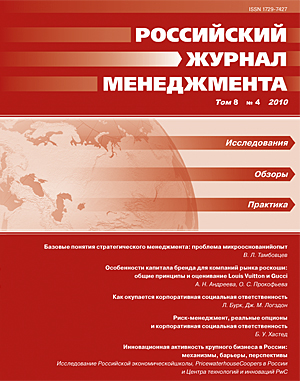Базовые понятия стратегического менеджмента: проблема микрооснований
Аннотация
В статье уточняются принципы проекта микрооснований стратегического менеджмента, сформулированного Т. Фелином и Н. Фоссом в 2005 г. На их основе предложено решение проблемы происхождения рутин, разработана структура понятия организационных способностей, критически проанализированы микрооснования динамических способностей фирмы, выдвинутые Д. Тисом в 2007 г.
Ключевые слова:
микрооснования, рутины, организационные способности, динамические способности
Скачивания
Библиографические ссылки
REFERENCES IN LATIN ALPHABET
Загрузки
Опубликован
Как цитировать
Выпуск
Раздел
Лицензия
Статьи журнала «Российский журнал менеджмента» находятся в открытом доступе и распространяются в соответствии с условиями Лицензионного Договора с Санкт-Петербургским государственным университетом, который бесплатно предоставляет авторам неограниченное распространение и самостоятельное архивирование.





